Removing
Disconnect the negative battery terminal.
If necessary, note the exact location of each HV wire for later installation, then disconnect the wires from the spark plugs (do not pull the wires, pull the connectors). Disconnect the HV wire from the coil in the same way. Separate the wires from the clamps on the camshaft cover.
Loosen the two clips with a screwdriver and remove the distributor cover together with the HV wires from the distributor.
Disconnect the distributor connector (pic. 5.1).
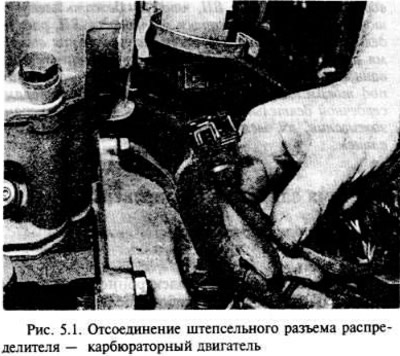
Disconnect the vacuum hose from the diaphragm assembly on the distributor side.
If you need to install the old distributor, make marks to align them between the distributor housing and the camshaft housing so that the distributor can be put in its old place.
Using the appropriate wrench and crankshaft pulley bolt, or by shifting to a higher gear (Manual Transmission) and pushing the car back or forward (with released hand brake), crank the crankshaft to move the No. 1 piston to the ignition point. Piston No. 1 is at the ignition point if:
- A) the arrow of the ignition pointer on the rear cover of the timing belt is aligned with the mark 10°to TDC, located on the crankshaft pulley (pic. 5.2);
- b) the end of the rotating cam indicates the position. occupied by the high voltage wire terminal to cylinder No. 1 in the ignition distributor cover;
- c) the rotating cam is aligned with the mark on the distributor body (remove the lever and plastic shield, then install the lever to check the alignment with the mark) (pic. 5.3).
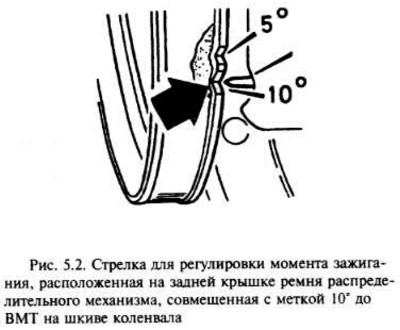

Loosen the nut and remove the clamping plate. then remove the distributor from the camshaft housing (pic. 5.4. 5.5. 5.6).
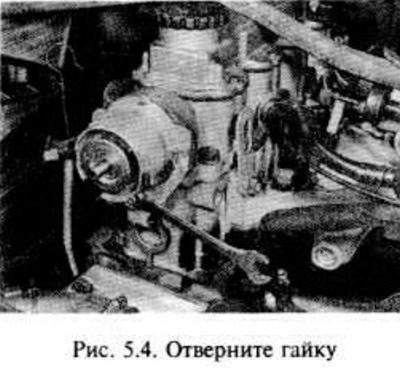
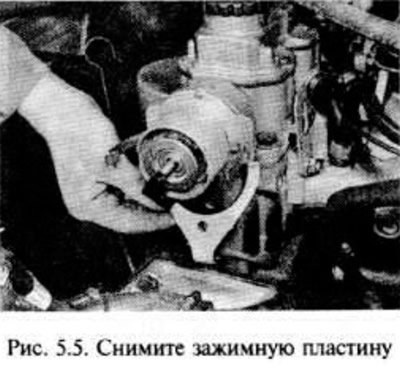
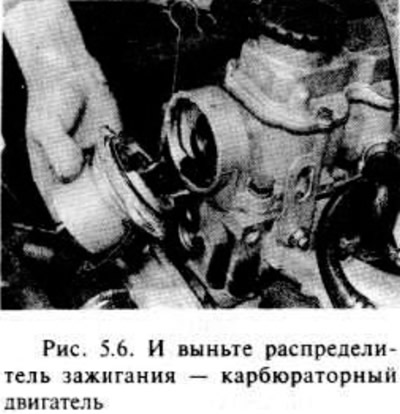
Repair
After removing the distributor, remove the lever and the plastic screen.
Although the top support plate can be removed after removing the two screws - this is for educational purposes only, spare parts are not available.
Optionally, the vacuum diaphragm assembly can be removed by unscrewing the two screws and disengaging the lever from the base of the distributor plate.
The vacuum device can be checked by suction through the vacuum hole. Turn off the vacuum and check if the operating rod returns to its original position. If not, replace the vacuum assembly.
Check the distributor cap for corrosion and deposits. the sign of which is a thin black line between the segments. Make sure that the carbon brush in the center of the cover moves freely and that the surface of the cover is clean. If necessary, replace the cap.
If the metal part of the rotating cam is badly burned or loose, replace it. If it is slightly corroded or burned, then it can be cleaned with a velvet file.
Check the o-ring located on the back of the distributor housing and, if necessary, replace it.
Reassembly is in the reverse order of disassembly, making sure that the operating lever of the vacuum device is engaged with the pin on the main plate, which will require several attempts.
Installation
Start the installation by checking that the piston in cylinder no. 1 is still at the ignition point. The corresponding ignition timing marks must be centered. If the engine was cranked while the distributor was removed, check the position of the piston in cylinder No. 1 and make sure it is at the ignition point by removing the spark plug and pressing your finger against the spark plug hole. Rotate the crankshaft until you feel compression (pressure), which indicates that the piston N 1 rises, making a compression stroke. Continue cranking the crankshaft until the corresponding ignition marks match up.
Rotate the rotating cam to the position shown in line (With) - paragraph of this subsection "Rotating cam..." and hold it there while installing the distributor, making sure that the distributor drive shaft engages with the camshaft. If the old distributor is installed, it is necessary to combine the marks on the distributor housing and the camshaft housing.
Install the clamp plate and nut, but do not fully tighten it at this stage.
Remove the rotating cam, then install the plastic shield and lever.
Connect the vacuum tube to the diaphragm assembly.
Connect the distributor plug.
Install the distributor cap, making sure that the HV wires are connected correctly.
Connect the negative battery terminal.
Check and, if necessary, adjust the ignition timing.

Visitor comments